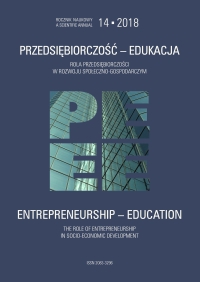Entrepreneurship as a Factor in the Development of Camino de Santiago in Poland
DOI:
https://doi.org/10.24917/20833296.14.22Keywords:
Camino de Santiago, entrepreneurship, pilgrimages, religious tourism, Way of St. JamesAbstract
In 2003 the European network of Camino de Santiago - Way of St. James reached the border between Germany and Poland in Görlitz - Zgorzelec. In the following year, a group of fans of the Way of St. James in Poland started activities aimed at setting out and marking the first Polish sections of the pilgrimage route to Santiago de Compostela. In the next years, many regions of Poland witnessed initiatives of marking new sections of the Way of St. James. The projects were finalised with an impressive number of 34 marked Polish sections of the Way of St. James which jointly made the network of Camino de Santiago of a length of more than 6,460 km. Selected sections of the Way of St. James in constitute the subject of research. Field studies were conducted during the years 2006-2017 in twelve Polish sections of Camino de Santiago. A length of more than 1,200 kilometres of the Route of St. James was examined (by walking). The objective of the research was to learn about transformations in the sector of tourism services which occurred on selected Polish sections of the Way of St. James and to analyse entrepreneurial activities undertaken both by local government authorities, tourism associations and organisations, Brotherhoods and Associations of St. James, and businesses in order to develop pilgrimage movements, religious tourism and cultural tourism on the analysed route. When presenting research results, mainly the descriptive and analytical method, cartographic presentations methods and statistical methods have been used. The conducted research has shown that the designing, setting out and marking of 34 Polish sections of Camino de Santiago is mainly the contribution of groups of fans of the Way of St. James, Camino pilgrims, members of the Brotherhoods of St. James and Associations of St. James, and priests. In the majority of cases, this was a “grassroots” initiative and an expression of social entrepreneurship of dozens of people. It was only at subsequent stages of the development of the Way of St. James in individual regions that local government authorities gradually joined “Camino” projects.References
Antkowiak, W. (2007). Szlak św. Jakuba. Polska Droga. Odcinek Olsztyn – Toruń. Przewodnik dla pielgrzymów i turystów. Toruń.
Bielicki, T., Roszak, P. (2012). U progu Camino. Przewodnik po kujawsko-pomorskim odcinku Szlaku św. Jakuba. Toruń: Wydawnictwo Naukowe UMK.
Bożek, R., Czajka, W., Kazimierczak, J., Madej-Janiszek, R., Pawlikowski, J., Przygoda-Golenia, A., Skwierczyńska-Mizerska, B., Stefaniak, Ł. (2015). Droga Świętego Jakuba Cudu nad Wisłą. Przewodnik pielgrzyma. Warszawa: Konfraternia Świętego Apostoła Jakuba Starszego przy Katedrze Polowej Wojska Polskiego w Warszawie.
Duda, M., Duda, T. (red.). (2013). Pomorska Droga św. Jakuba. Przewodnik turystyczny. Szczecin: Fundacja Szczecińska.
Hass, W. (2008). Z Jakubowa do Santiago de Compostela. Szlak, bractwo, sanktuarium. W: A Jackowski, F. Mróz, I. Hodorowicz (red.), Drogi św. Jakuba w Polsce – stan badań i organizacja. Kraków: Wydawnictwo „Czuwajmy”, 95–102.
Hołub, J.M., Mróz, Ł. (2013). Droga św. Jakuba Via Regia, Podkarpackie – przewodnik pielgrzyma i turysty. Jarosław: Stowarzyszenie „Przyjaciele Dróg św. Jakuba w Polsce”.
Kazimierczak, J. (2015). Warszawska Droga Świętego Jakuba Większego Apostoła. Przewodnik dla pielgrzymów i turystów. Warszawa: Jerzy Grzegorz Kazimierczak.
Madej-Janiszek, R. (2015). Mazowiecka Droga św. Jakuba. W: P. Roszak, F. Mróz (red.), Droga św. Jakuba w Polsce — historia, teraźniejszość i przyszłość. W 10. rocznicę otwarcia pierwszego polskiego odcinka Camino de Santiago. Kraków: Wydawnictwo „Czuwajmy”, 306–309.
Mendyk, E., Mróz, F. (2009). Droga św. Jakuba w Polsce. Kalendarium wydarzeń w latach 2004–2009. W: I. Hodorowicz, F. Mróz (red.), Pielgrzymi na Drodze św. Jakuba. Przeszłość i teraźniejszość. Nowy Targ: Wydawnictwo Podhalańskiej Państwowej Wyższej Szkoły Zawodowej, 77–85.
Mróz, F. (2014). Małopolska Droga św. Jakuba – geneza, rozwój, nowe wyzwania i perspektywy rozwoju. Rozprawy Naukowe Akademii Wychowania Fizycznego we Wrocławiu, 47(2014), 22–31.
Mróz, F. (2015). Droga św. Jakuba w Polsce – geneza i rozwój – w 10. rocznicę otwarcia pierwszego szlaku jakubowego. W: A. Wyrwa (red.), Camino de Santiago. Szkice historyczne do peregrynacji i dziejów kultu św. Jakuba Apostoła Większego (wydanie II). Lednica: Muzeum Pierwszych Piastów na Lednicy, 65–95.
Mróz, F. (2016a). Pielgrzymowanie polskimi odcinkami Drogi św. Jakuba na początku XXI wieku. W: P. Roszak, W. Rozynkowski (red.), Camino Polaco. Teologia – Sztuka – Historia – Teraźniejszość, t. 3. Toruń: Wydawnictwo Naukowe Uniwersytetu Mikołaja Kopernika w Toruniu, 177–202.
Mróz, F. (2016b). Znaczenie europejskich szlaków pielgrzymkowych w budowaniu tożsamości Europy – przeszłość i teraźniejszość. W: M.C. Hastetter, M. Ostrowski (red.), Pielgrzymi, drogi, święte miejsca. Duszpasterstwo w kontekście podróży. Kraków – Trumau: Wydawnictwo UNUM, 185–199.
Mróz, F., Bordun, O. (2016). The Origin and Functioning of the Lviv Way of St. James Via Regia and Its Importance in the Development of Pilgrimages and Religious Tourism at the Polish-Ukrainian Border. Annales Universitatis Paedagogicae Cracoviensis Studia Geographica, 10(2016), 120–138.
Mróz, F. (2017). How has Camino developed? Geographical and Historical Factors behind the Creation and Development of the Way of St. James in Poland. W: E. Alarcón, P. Roszak (red.), The Way of St. James: Renewing Insights. Navarra: Ediciones Universidad de Navarra, 59–80.
Stefaniak, Ł., Wasiak, E. (2017). Ze Świętym Jakubem do Świętego Józefa. Warszawa – Kalisz po Drogach Świętego Jakuba: Mazowieckiej, Szopenowskiej, Warszawskiej, Łowickiej. W: P. Roszak, F. Mróz, Ł. Mróz (red.), Dziedzictwo religijne i kulturowe Drogi św. Jakuba – w 30. rocznicę uznania szlaku za pierwszy Europejski Szlak Kulturowy. Kraków: Wydawnictwo „Czuwajmy”, 319–339.
Szeszko, R., Góralczyk P. (2015). Lubuska Droga św. Jakuba. Murowana Goślina – Słubice. Przewodnik Pielgrzyma. Wrocław: Stowarzyszenie „Przyjaciele Dróg św. Jakuba w Polsce”.
Zioło, Z. (2012). Procesy kształtowania miasta innowacyjnego. Studia. Polska Akademia Nauk. Komitet Przestrzennego Zagospodarowania Kraju, 141(2012), 39–60.
Downloads
Published
How to Cite
Issue
Section
License
Articles are published under the terms of the Creative Commons License (CC BY-ND 4.0; Attribution– NoDerivs).

